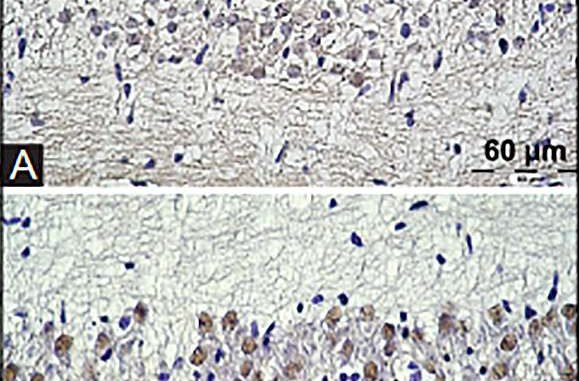
Trefoil factor family (TFF) peptides have been investigated for the last 35 years, mostly in the context of gastrointestinal mucosa, where they are secreted the most. They exert a protective role in the mucosa by facilitating the injury repair process and contributing to the function of the protective mucous layer. Their presence, or in some cases, absence is connected to tumor genesis and other pathological conditions of different organs’ mucosa. Several studies found that members of this peptide family (TFF1 and TFF3 peptide) are synthesized in the central nervous system of different mammal species, and their role there is still elusive. Some studies showed that TFF3 peptide affects animal behavior, learning, object recognition and retention of memory and is connected to brain atrophy and Alzheimer’s disease.
Since no data were available on the expression of TFF peptides in the nervous system during embryonic development, as a part of our embryonic research on TFF peptides we used immunohistochemistry to determine presence and localization of TFF peptides in nervous tissues of mouse embryos on day 15 to 17 of embryonic development.
For the first time, we showed that TFF1 and TFF3 were present in the neurons of brain, spinal medulla and ganglia of mouse embryos. To our knowledge, this research is the first to find TFF peptides in the peripheral nervous system of any organism.
This study provided insight on the presence and localization of TFF1 and TFF3 peptides in embryonic nervous tissues of mice on late developmental stages. Unfortunately, their role in this context is still unknown. The study points out that further research is needed to explain the role of TFF peptides in the development and function of the nervous system. In order to get a more broad perspective, the research should also continue in younger embryonic stages. Since these peptides are known to influence cell migration, proliferation, apoptosis and angiogenesis, it would be very interesting to see if they affect brain physiology and pathology.
SAŽETAK NA HRVATSKOM JEZIKU
Obitelj trefoil factor peptida (TFF, od engl. Trefoil factor family) istražuje se već 35 godina i to uglavnom u kontekstu sluznice probavnog sustava, gdje se najviše izlučuju. Ti peptidi štite sluznicu tako što olakšavaju popravak njenih oštećenja i doprinose pravilnoj funkciji zaštitnog sloja sluzi. Njihova prisutnost, ili, u nekim slučajevima, odsutnost povezana je s nastankom tumora i drugim patološkim procesima sluznice različitih organa. Nekoliko istraživanja otkrilo je da su članovi ove obitelji (TFF1 i TFF3 peptid) prisutni u središnjem živčanom sustavu različitih sisavaca, no njihova je uloga tamo još uvijek nejasna. Neka istraživanja pokazala su da TFF3 utječe na ponašanje životinja, učenje, prepoznavanje objekata i zadržavanje pamćenja, a povezan je i s atrofijom mozga i Alzheimerovom bolesti.
S obzirom da nije bilo dostupnih podataka o ekspresiji TFF peptida u živčanom sustavu tijekom embrionalnog razvoja, kao dio naših embrioloških istraživanja TFF peptida koristili smo imunohistokemiju kako bi odredili prisutnost i smještaj TFF peptida u živčanom sustavu mišjih zametaka tijekom 15. do 17. dana embrionalnog razvoja.
Prvi put do sada pokazali smo da su TFF1 i TFF3 peptid prisutni u neuronima mozga, kralježnične moždine i ganglija mišjih zametaka. Koliko nam je poznato, ovo je prvo istraživanje u kojem su TFF peptidi pronađeni u perifernom živčanom sustavu bilo kojeg organizma.
Ovo istraživanje dalo nam je uvid u prisutnost i smještaj TFF1 i TFF3 peptida u živčanom tkivu mišjih zametaka u kasnim razvojnim stadijima. Na žalost, još uvijek je nepoznata uloga koju oni ovdje imaju. Istraživanje ističe da su potrebna dodatna istraživanja kako bi se razjasnila uloga TFF peptida u razvoju i funkciji živčanog sustava. Kako bi se mogla sagledati šira slika, istraživanja bi se trebala nastaviti na ranijim stadijima zametaka. S obzirom da ovi peptidi utječu na migraciju i proliferaciju stanica, apoptozu i angiogenezu, bilo bi zanimljivo detaljnije istražiti kako utječu na fiziološka i patološka zbivanja u mozgu.
This study was published as:
Tatjana Belovari, Nikola Bijelić, Maja Tolušić Levak, Mirela Baus Lončar. Trefoil factor family peptides TFF1 and TFF3 in the nervous tissues of developing mouse embryo. Bosn J Basic Med Sci. 2015 Feb; 15(1): 33–37. doi: 10.17305/bjbms.2015.251
Leave a Reply